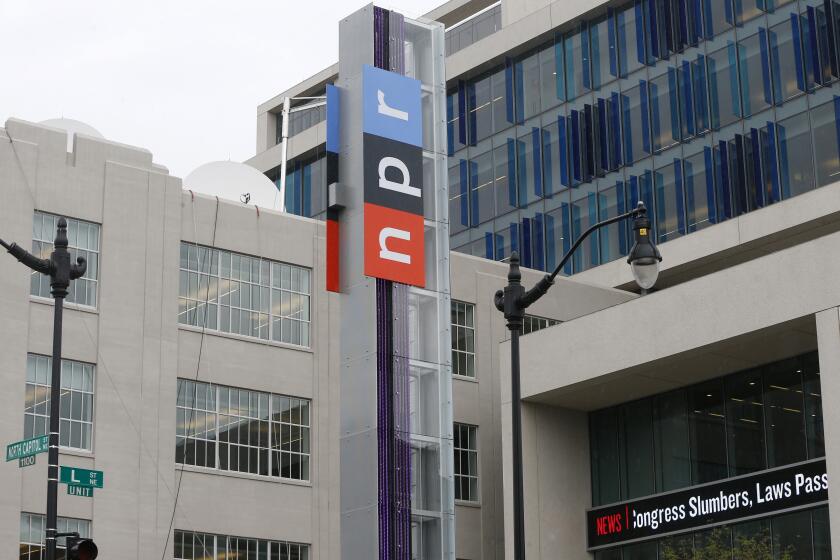News Divisions Reluctant to Drop Anchors
- Share via
NEW YORK — Brian Williams has what you might call a Prince Charles problem. What happens to a guy who trains his whole life for a job that just never seems to open up?
There’s an anchor logjam in television news, and a whole class of TV journalists, including NBC’s Williams, CBS’ John Roberts and others, has been prepped for one of those prestigious posts and led to believe that one day it might be theirs, along with the commensurate riches and fame.
But the men and women at the top don’t appear to be going anywhere anytime soon. CBS’ Dan Rather has hit 70 and is still going strong. Peter Jennings is widely expected to renew his expiring ABC contract, assuming the two sides can work out suitable pay at a time when many ABC on-air people have been asked to take salary cuts up to 25%.
Katie Couric made noises about leaving NBC’s “Today,” then signed a new deal that allows her to stay on for nearly five years if she wants. Stone Phillips and Jane Pauley were feted last week in New York for their 10 years anchoring NBC’s “Dateline.”
ABC even turned to two existing prime-time anchors, Diane Sawyer and Charlie Gibson, when it needed a quick fix for “Good Morning America,” but their temporary double-duty posts have now stretched into three years.
That has left many people vying for the few open positions, including the slot being vacated by Bryant Gumbel at CBS’ “The Early Show,” whose last day is expected to be May 17, according to CBS News executives. And that job may not even go to a network news person, but to game-show host Tom Bergeron, who is scheduled to substitute this week as well as the week after Gumbel leaves, according to executives there.
The low turnover is due to reluctance by network executives--worriedly eyeing declining viewer interest in network news over the last decade as cable has blossomed--to start over with anchors who aren’t household names. ABC gambled unsuccessfully on lesser-known morning anchors Lisa McRee and Kevin Newman before turning to Sawyer and Gibson; any change in that time slot will again mean a period of rebuilding, just as the program is gaining traction.
Viewers tune in for established anchors, says talent agent Ken Lindner, and losing them would invite viewers to surf. “It’s daunting, because you run the risk of losing part of your core viewership,” he says.
“Tom, Peter and Dan are called the Big Three for a reason,” says Williams of the three evening news anchors, one of whom he may someday replace. “In this business, you don’t earn your salary 364 days a year; you earn it one day a year, when America, ‘the nation turns its lonely eyes to you,’” he says, quoting Simon and Garfunkel. “These guys are terrifically good at what they do, and the jobs are too important for them to be handed out on a whim. It’s important for them to stay in them as long as they can.”
But if this strategy of stability has emerged for competitive reasons, it has also benefited a broadcast competitor: cable news. Tired of waiting for an anchor post at ABC, Aaron Brown jumped to CNN, where he has a nightly program. Connie Chung, likewise, found herself being paid an anchor’s salary without an anchor job at ABC, where Sawyer and Barbara Walters of “20/20” are firmly ensconced. She, too, is now at CNN.
Forrest Sawyer went to MSNBC after a stint as a well-regarded ABC substitute anchor, and Fox News Channel hired Brit Hume from ABC News.
“I think that now, if you want to be an anchor, you work for local stations or for cable,” says Marcy McGinnis, senior vice president of news coverage at CBS News. In cable, she says, “the good news is there are a lot more anchor jobs, and the bad news is, nobody’s watching.”
The three network evening newscasts combined draw an average of 30 million viewers. By contrast, the top-rated cable hour in prime time, “The O’Reilly Factor,” averaged an estimated 2.1 million during the first quarter, according to Nielsen Media Research.
Still, the migration of talent with network experience has brought more visibility to cable and been made possible as cable networks, locked in their own competitive battle, have increased the amount they are willing to pay. Chung is thought to be making just over $2 million annually at CNN, a far cry from CNN’s early days when the channel was notoriously cheap.
Larry King, CNN’s most-watched personality, makes close to $7 million a year, and Fox News Channel’s Bill O’Reilly, who has cable news’ highest-rated show, takes home an estimated $4 million a year.
Still, most cable salaries aren’t in the $5 million-to-$10 million bracket that a top network anchor commands. Couric, whose “Today” is the most profitable network news program, pulls in more than $15 million a year. With a few exceptions, those network salaries are dropping, however, as networks try to rein in costs.
The Holy Grail of anchor posts is still considered a network evening newscast, whose anchors have been in place roughly two decades each. NBC’s Tom Brokaw gave hope to aspiring anchors in recent years when he started musing about retiring at the end of this summer, but he is still on the fence, at least publicly.
If he stays, that would be a blow to Williams, who has been groomed for the job and currently occupies prime real estate at sister channel MSNBC, where he anchors an hourlong nightly newscast in addition to being Brokaw’s designated sub. Some NBC executives worry that should Brokaw stay, NBC will lose Williams, who also has CBS News interested, although Rather shows no sign of cutting back. Williams declined to comment on his personal situation.
Whether someone lands an anchor slot is “a lot about timing and luck, when things come open,” says Amy Entelis, senior vice president of talent recruitment and business affairs for ABC News. Chung and Brown, she says, “maybe didn’t want to wait and saw a better opportunity and grabbed it.”
But, she says, it can also “be a bad thing to get the label ‘heir apparent.’ People in our business sit with bated breath and say, ‘When, when, when,’ and that can be undermining.” Those who do well, she says, are those who continue to report at the same time as they anchor. “The direction of the business is you have to have flexibility, to not be one thing.”
In fact, ABC has had its best year in some time for promoting new anchors, Entelis says, and those have been strong correspondents, including Robin Roberts, just named the news reader at “Good Morning America.” Some of the opportunity, she says, was created by the year’s news, “a series of stories bigger than we ever imagined, which showed people in new light.” That included John Miller, who, having done several well-regarded reports on terrorism, was named Barbara Walters’ “20/20” co-anchor.
“We don’t get to replace a ‘20/20’ anchor but every 10 or 15 years, but the timing was right,” Entelis says.
An anchor position at Sunday’s “This Week” is also expected to open up, with Cokie Roberts stepping down. ABC is discussing whether to give Sam Donaldson another assignment and put George Stephanopoulos in the job.
Rather’s job and the morning position aside, CBS has chosen to go largely anchor-less, preferring to be known for a strong group of correspondents.
“There’s less frustration here,” as a result, says McGinnis. “Everyone’s not clamoring for Dan’s chair; they’re clamoring to be on ’60 Minutes’ and ’60 Minutes II’ and there’s a realistic expectation to get there.”
More to Read
The biggest entertainment stories
Get our big stories about Hollywood, film, television, music, arts, culture and more right in your inbox as soon as they publish.
You may occasionally receive promotional content from the Los Angeles Times.










